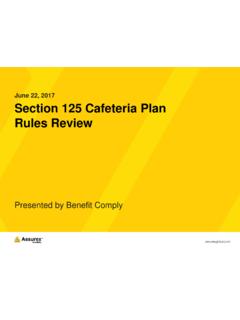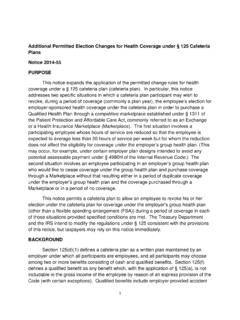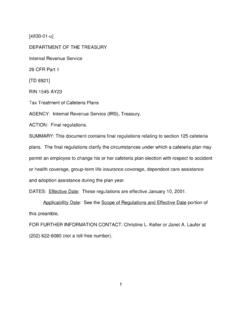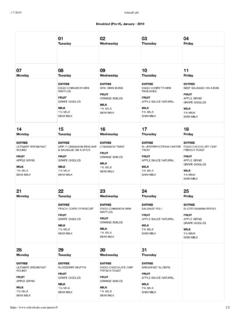Transcription of Flex Credit Cafeteria Plans - POLESTAR BENEFITS
1 flex Credit Cafeteria Plans : How this Cafeteria plan Design can Help Employers Maintain Costs in 2014 and Beyond Introduction The most complex form of a Cafeteria plan is the full flex or " flex Credit " plan . This type of plan is a true Cafeteria plan in which employees can choose among different taxable and non taxable BENEFITS . Employees use benefit dollars or credits that are offered by the employer to select the BENEFITS that meet their individual needs. The employer can use a full flex Cafeteria plan in conjunction with a defined contribution to set an amount that it wants to contribute to the BENEFITS and allow employees to pay the remainder. flex Credit Plans The money in a flex Credit plan comes from both employer or employee contributions. The employer contributes to a flex Credit plan by defining the amount of flex credits that it makes available under the plan .
2 Employees then have the option to: Use the money that is made available by selecting a less expensive health coverage option and also purchase other BENEFITS or take the remainder in cash. Use the money to purchase a higher level of health coverage and not select any other BENEFITS . Select the BENEFITS that the employee needs and supplement the cost with its own pre tax contributions The employer can determine the amount made available to each employee for all BENEFITS or for each type of benefit, ie medical, dental, vision, etc. The benefit options that may be included in a flex Credit plan depend on the employer's objectives for the plan . BENEFITS that are typically included are health Plans , group term life insurance, dental, vision, disability and time off with pay. Unused flex credits, at the employer's or employee's option, can be dumped into the employee's health FSA or cashed out, meaning the employee takes those unused dollars as taxable income.
3 If the flex credits can be used in the health FSA, however, the employer should be careful to limit the amount that can be contributed to $500 or less to ensure that the health FSA remains an excepted benefit. Some of the key issues that employers need to be aware of when using a flex Credit Plans include: 1) flex Credit Plans can be complicated for employees to understand so communication is important. 2) Too much flexibility and choice may cause frustration for employees. 3) Designing the plan can be a little more time consuming for employers, unless they take a basic defined contribution approach and set a flat dollar amount for all BENEFITS with differences only for single v. family coverage. 4) Employers may experience an increase in time spent on internal administration to track credits or will need to use a vendor or software system to track them and administer the plan .
4 5) Adverse selection of BENEFITS or cash can be a problem. Employees may only select dental, for example, if they have a need for dental work. To prevent too many employees from selecting cash employers may want to eliminate the cash option or may want to require proof of other coverage for employees who do not elect . Another approach that the employer could take would be to discount the cash out option. For example, the unused credits may equal $500 but if the participant wants to elect cash, he or she only gets 50 or 25 on the dollar. 6) Limits on taking credits as cash, such as requiring proof of other coverage when waiving the employer's health plan , are also important under the Fair Labor Standards Act to avoid having to include this taxable income in an employee's income when calculating over time.
5 How a Defined Contribution flex Credit plan can be used with a Private Exchange With a flex Credit Cafeteria plan , an employer will typically want to offer a menu of benefit options for the employees. These options will allow an employee to select the benefit designs and options that fit the employee's needs. A private exchange is a term that describes the mechanism through with employees select from this menu of BENEFITS . Although an employer can offer a menu of BENEFITS by listing the options on paper, by using a software system for the private exchange, the employer can both limit its administrative responsibilities and give the tools needed by the employees to make them the purchaser of the coverage. Employers that use a private exchange with a flex Credit approach are able to reduce their direct administrative costs.
6 Employers will no longer need to expend resources on tasks like employee and dependent eligibility, enrollment, plan selection, compliance, employee education, and employee claims questions. Instead, the employer outsources these items to the private exchange vendor. The appeal of private exchanges for employers is based primarily on two factors: simplicity and predictability. In terms of simplicity, from an employer's perspective, covering workers using an online exchange is considerably simpler than doing so through its own selection of benefit options. Gone are the headaches associated with selecting health Plans , managing open enrollment processes, educating employees about options, and negotiating with Plans about rates, services, and coverage. Human Resources and BENEFITS Managers are busy with other tasks and as insurance rules and requirements become more complicated, these employer representatives are just not equipped to handle the myriad of questions and issues that are faced by employees with different situations and needs.
7 Instead, with a private exchange, the employer's involvement is limited to directing employees to the exchange to select coverage, and paying a pre defined portion of the premium. Private exchanges with a defined benefit also offer employers the sort of cost predictability that is needed in today's insurance market. Employers set their contribution amount, determine how the money can be used, and can keep that contribution in future years or can determine how much of any premium increase it wants to absorb. Contact POLESTAR BENEFITS for more information about setting up a Private Exchange or for information about flex Credit Cafeteria Plans . 412 JEFFERSON PARKWAY, SUITE 202 LAKE OSWEGO, OR 97035 PH: (855) 222-3358 FAX: (888) 539-9565 EMAIL: 2011-2014 POLESTAR BENEFITS , INC.
8





